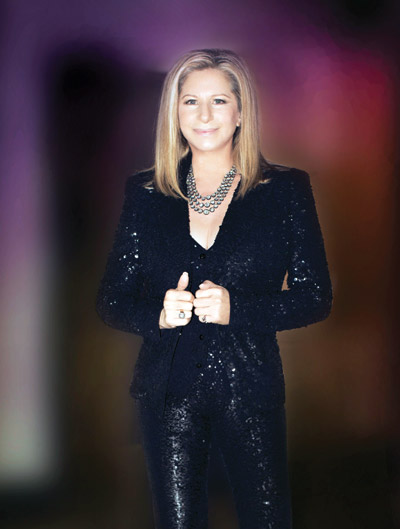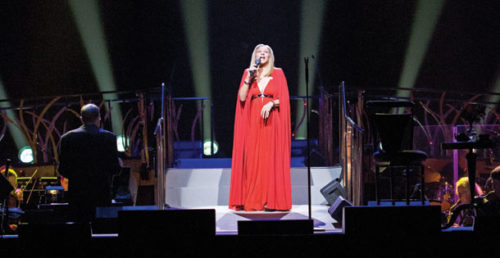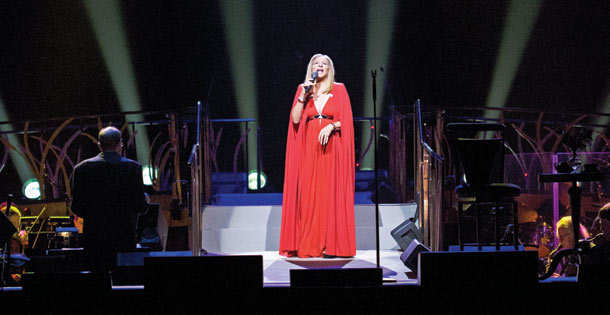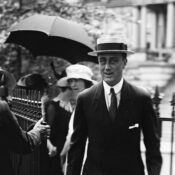To read how author Neal Gabler first became fascinated with Streisand, read “The Magic of Barbra Streisand: Interview with Neal Gabler” online December 6, 2016.

Photo by Russell James/Copyright Barwood Films, Ltd.
It is one of the seminal moments in American film and, quite possibly, American culture generally. The camera dollies in toward a woman in a leopard-skin coat and matching hat, her back to the camera, then veers slightly to the left to reveal an ornate, gold-framed, full-length mirror in which we see the woman’s image, though her face is obscured by the coat’s collar. She pulls down the collar just enough to reveal that inimitable Streisand visage, arches her brows, and assesses herself — coolly. Then she purrs, “Hello, gorgeous.” There is a cut to a close-up, and Streisand emits the tiniest, almost inaudible laugh/snort, as if it were a joke, though she acts as if the joke is on us. It is. But then her expression turns dark, wistful, as if to tell us how far she has had to come to utter those words.
This is how Barbra Streisand introduced herself to the film audience in Funny Girl in 1968, and what an introduction it was! First, there is her look — a kind of exoticism, half Afghan hound, half Jewess. And then there is the manner — the secretiveness, the cool, diva elegance only slightly betrayed by those arched brows, the self-scrutiny that gives way to self-consciousness that gives way to self-confidence that gives way to self-doubt. And then there is the voice — that unmistakable Brooklyn accent, the “gorgeous” elongated to “gaaaaw-jus,” an accent that just didn’t comport with the regal bearing, the expensive coat, the sense of control. And then there is that laugh, as if to say … well, it said a lot. And then that sadness, which said even more.
One of the things it said is that Streisand wasn’t making fun of herself or being ironic — she was gorgeous — even though no one who looked like Streisand or had Streisand’s obvious ethnicity, that double whammy of Judaism and Brooklyn, or had that strange self-regard Streisand had, had ever become an American movie star, certainly not a dramatic star, and Streisand would become the biggest. When Streisand addressed her image in that mirror, she was asserting her beauty and validating a new kind of glamour, a new kind of star, a new kind of power. “Hello, gorgeous” was Streisand’s way of ushering in a new era, and just about everybody seemed to recognize it. Although there had never been anyone on movie screens like Streisand, there were millions of Streisands, tens of millions, watching those screens, as Streisand herself had before she became a star. Now they had someone of their own — someone whom they didn’t have to dream of becoming, which was the general vicarious transaction for movie audiences, but someone they felt they already were.
It may seem peculiar to freight an entertainer with that much psychological and cultural weight, but Streisand isn’t just an entertainer. She has long been a cultural force — the kind of personality who inspires effusions, poems, stage plays, art, songs, even a viciously hostile South Park episode. After 50 years in our eyes and our ears, she is part of the American consciousness as few entertainers have been.
Obviously, none of this would have happened without her enormous talent. She was the “most successful, and perhaps talented, performer of her generation,” Michael Shnayerson wrote in Vanity Fair. Almost from the moment she first sang publicly, at the age of 17, she elicited adulation. The classical pianist Glenn Gould called her voice “one of the natural wonders of the age,” and composer Quincy Jones called it a “Stradivarius of a voice.” Most music critics regard her as the greatest popular female vocalist, and the only singer to stand comparison to Frank Sinatra. Like Sinatra, she changed the dynamics of American popular singing, and she spawned a generation of imitators. Every time you hear a female vocalist trilling in the highest registers or stretching a vowel or shaping the air with her hands or putting on the Bernhardt, you can rest assured that Streisand was there first.
But talent alone, even talent as abundant as Streisand’s, doesn’t make a cultural icon. It may not even be a prerequisite. What makes an entertainer into a cultural icon is the way in which he or she strums our psychic chords and comes to serve as an embodiment of our own deep impulses. He or she seems not only to understand us but to express us. The lives of such rare entertainers, or at least the lives they express through their work, comprise a theme about us.
Usually this appeal is subtext, a whisper under the performance: Marlon Brando’s brooding iconoclasm, Sinatra’s cool, the Beatles’ irreverence. In Streisand’s case, it was all text — a shout rather than a whisper. Streisand, whose mother discouraged her from pursuing show business because she felt her daughter was too unattractive to succeed; Streisand, who never even got the solo in her own high school chorus because a classmate sang more operatically; Streisand, who was immediately dismissed when she auditioned for parts because of her looks; Streisand, who seemed to be an afterthought in everything she attempted — Streisand stood for every plain girl who had ever been rejected.
She sang songs of loneliness and despair and longing. “People who need people …” “What’s too painful to remember, we simply choose to forget …” “You don’t bring me flowers anymore …” In her plaintive voice, one could hear and feel every slight, every insult, every wound. Tennessee Williams said of that voice that it was “pure and sweet but bolstered by so much rage, all of which had been invested in the pursuit of artistic excellence.” Only Streisand could take Franklin Roosevelt’s cheery campaign song, “Happy Days Are Here Again,” and turn it into a dirge. Streisand seemed to understand in the very depths of her soul how arduous life was. And her fans responded — responded because they knew she knew. One artist said of her, “To be an adolescent coming across Barbra Streisand was the most exhilarating moment of identification” Streisand was the girl who beat the odds, not by assimilating or changing but by not assimilating and not changing. As she herself put it, “You know, maybe not being a beauty explains my success. Maybe being the girl that guys never look at twice, and when I sing about that — about being like an invisible woman — people feel like protecting me.”
And hers was a Jewish-American success story, too. When she entered show business, she was told repeatedly that she would have to get a nose job if she were to have any hope of succeeding. Of course, she refused, in large part because, she said, she did not want to betray herself, which also meant betraying her Jewishness. As she once put it, “No nose job. Because most of all I want to be true to myself. Really, people should be left to themselves, instead of everyone trying to change everyone else.” Her Jewishness was both her social burden and her triumph. She was the entertainer of the marginal, the disenfranchised, the disadvantaged, the disaffected, the put-upon, and, not least of all, the different. Only Streisand, among all Hollywood’s blonde gentile beauties with their pert little noses, or its sexy bombshells, could really understand them.
And not only understand them but win for them. If in her songs she conveyed the pangs of lost love, she also conveyed the defiance to soldier on. Just listen to her rendition of “Cry Me a River” and you hear the anguish turn into strength. And if, in her films, she always portrayed the ugly duckling, she also made that duckling into someone indomitable and self-confident. She was neither sultry nor sweet, neither a siren nor the girl next door — unless you happened to live in one of America’s urban enclaves. She played a woman who was loud, uninhibited, smart, brassy, sassy, and kooky (a word frequently used to describe the young Streisand) — the point being that if she didn’t look like any female star, she didn’t act like one either. She was a force of nature.
Streisand began as a coterie entertainer, winning favor with those who were a little off-center as she herself was, rather than an entertainer with immediate mass appeal. By 1963, when she hit the hungry in San Francisco, the word of mouth had built, the coterie had grown, and she was beginning to attract larger audiences, just as she had done earlier in New York. And by the time she hit the Basin Street East back in New York that May, with its 450-seat room and on the same bill with Benny Goodman, her first album had become a full-fledged success. Radio DJs had even begun playing “Happy Days,” and The Barbra Streisand Album slowly climbed the Billboard album list until it hit No. 8, making her the best-selling female vocalist in the country. It would stay on the list for 24 weeks and win her a gold record.
Her manager, Marty Erlichman, would call The Barbra Streisand Album the “turning point” in her career — the moment she went from being a New York phenomenon to a performer with a “national reputation.” The proof may have been that President John F. Kennedy had caught her appearance on The Dinah Shore Show early that May — a performance of which one critic said she was a “Flatbush gamine with the tonsils of a fish peddler” — and asked that she be invited to perform at the White House Correspondents Dinner. “How long have you been singing?” the president asked her afterward. “About as long as you’ve been president,” she shot back.
When she opened at the Cocoanut Grove at the Ambassador Hotel in Los Angeles, the audience was a who’s who of moviedom, but Streisand didn’t trim her sails to appease them. Instead, she took the stage by walking up the aisle from the back of the room, wearing a pink gingham dress intended as a spoof on The Sound of Music, then looked out at the audience, said she was the only one she didn’t recognize, and delivered a line that couldn’t help but bring down the house: “If I’d known you were going to be on both sides of me, I’d have gotten my nose fixed.” This was Streisand in her element, which was people who really appreciated her.
She was on a roll, and she knew it. Taping The Judy Garland Show the next month, Judy, who was clearly intimidated, nervously asked Streisand if there was anything more she could possibly want in life. To which Streisand blurted, “Yes, there is. I’d like to take over your show.” She effectively did, scoring with a brilliant duet with Garland that remains Streisand lore: Garland sang “Get Happy,” while Streisand counterpointed with “Happy Days.” It ended with Ethel Merman pretending to wander onto the set: one former diva, one current diva, and one future diva all sharing the stage. The murmurs about the show at CBS were so strong that the network decided to rearrange its schedule and rush it onto the air the following week.
There may be no other entertainer whose own life conflates with her work as much as Streisand’s does. That life, which traced an arc from a poor, awkward, neglected Brooklyn girl to a self-possessed woman, from an outsider to a guiding light, was also the story she repeatedly told in her films. In effect, she was simultaneously living her story and telling her story in her work, basically performing her life. She became popular by demonstrating how someone like her, someone with her seeming disadvantages, could become popular.

Russell James/Copyright Barwood Films, Ltd
While this forged an iron bond between performer and audience that has lasted decades, it also turned Streisand into a cultural trailblazer — again, in a way that no other entertainer was or is. Streisand arrived at the beginning of the feminist movement, and her gutsy, unsinkable, indomitable persona resonated with women. “Today you cannot imagine what it was like when Streisand burst on the scene in the 1960s,” Camille Paglia wrote. “There was nothing like her. … Barbra Streisand broke the mold, she revolutionized gender roles.” It wasn’t only that she was tough and tough-minded. It was that Streisand never let herself be defined by a man, which is why her untraditional looks didn’t seem to cause her the anguish women had always suffered under the withering judgment of men. She found a lure beyond conventional attractiveness — something deeper. It was the critic Pauline Kael who identified it and made what may be the most astute appraisal of this psychological legacy of Streisand’s: Streisand was proof that “talent is beauty.”
Almost singlehandedly in the world of entertainment, Streisand demonstrated that, for a woman, looks weren’t everything. She had this uncanny confidence that her talent was what counted, that it would trump everything else, and that embracing who she was became instrumental to that talent as it became instrumental to her admirers. This is how Tennessee Williams, a huge Streisand fan, put it to a friend: “She makes me believe in my talent, because she so passionately believes in and shares her own. She makes me believe in all the talents in all of the world.”
As odd as it may seem now, this idea that women were more than the sum of their looks was so original and empowering that Streisand changed or, at the very least, signified the change in how women came to think of themselves. It is not too much to say that she helped redefine femininity and beauty. And she did more. She became an example of empowerment — first as a star who made her own decisions; then as a producer who controlled her own films; and then as a director who bulled her way into Hollywood’s creative sanctum sanctorum, where women had never been welcome.
With Streisand, Hollywood had no choice. She was a force with whom everyone in the film industry had to reckon. No woman in film had ever had that kind of power, save possibly for Mary Pickford at her peak. All of these qualities made Streisand arguably the most important entertainer of her time — as Paglia wrote, a revolutionary. Just how much she challenged the prevailing moral, social, sexual, and cultural order may be seen in even greater focus by those who detested her. Streisand was a threat to every verity of traditional America — to conventional ideas of beauty, conventional ideas of female roles and femininity, conventional ideas of decorum, conventional ideas of the exercise of power, conventional ideas of what it meant to be American.
But it testifies to her iconic position in the culture that she could be a diva, which, for a poor, plain Jewish girl from Brooklyn, may be the greatest transformation of all. Streisand isn’t just a brilliant singer and actress, not even just a significant cultural figure. She has ascended into the American pantheon, where — ironically, for someone who made it by seeming ordinary — the normal rules no longer apply.
—
Excerpted from Barbra Streisand: Redefining Beauty, Femininity, and Power, by Neal Gabler, new from Yale University Press/Jewish Lives, copyright © 2016 by Neal Gabler. Reprinted by permission. Gabler’s next book is Against the Wind: Edward Kennedy and the Tortuous Course of American Liberalism.
Become a Saturday Evening Post member and enjoy unlimited access. Subscribe now




Comments
This is, for the most part, a terrific article about a legendary performer. However, for me the article was almost ruined by the author’s nonsensical comment about Judy Garland. I remember Judy’s show and the historical appearance of the three incomparable divas together… Ethel Merman, Judy Garland and Barbra Streisand. Judy Garland was in no way intimidated; nor was she nervous. The author may know a lot about Barbra Streisand, but he knows nothing about Judy Garland. It seems all to common in our culture to build one person up by tearing another one down. I have the great honor and memories of having seen each of them perform live, and I guarantee you no one or nothing would intimidate any one of them.